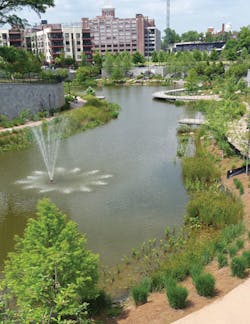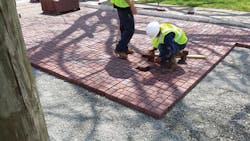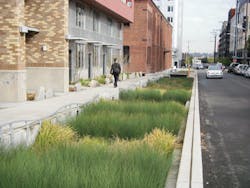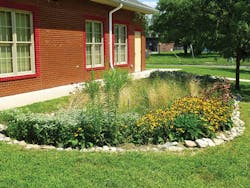By Sarah Fister Gale
Green stormwater infrastructure has become a mainstream strategy for cities across the country to reduce the risk of combined sewer overflows and naturally filter water before returning it to the water table. But its impact is being felt well beyond the water utility. Unlike gray infrastructure, which exists out of sight and underground, green systems take the shape of parks, rain gardens, and landscaped roads that add beauty and open space for the community to enjoy.
“It ties together resource recovery and a strong sense of community benefit,” said Adam Krantz, CEO of the National Association of Clean Water Agencies (NACWA) in Washington, D.C. Krantz noted that green infrastructure plays a prominent role in the Utility of the Future Blueprint for Action, an annual report jointly produced by NACWA, the Water Environment Federation (WEF), and the Water Environment Research Foundation (WERF), outlining how wastewater utilities are progressing beyond simply complying with the Clean Water Act to actually improve environmental performance while lowering costs, increasing revenue and helping boost the local economy.
“Green infrastructure is still in its infancy,” he said, but utilities and regulators are getting more comfortable with the value it brings, especially as major cities like Philadelphia, Seattle and Atlanta demonstrate impressive results through these investments. “We are getting to the point where there is sufficient information about what works, and those who have done it are open to sharing their successes and mentoring other cities.”
Once a Pond a Time in Georgia
Atlanta has been a leader in green infrastructure since implementing its first system in 2011: a two-acre pond and surrounding park built in the city’s historic Fourth Ward. The nine million gallon detention pond captures stormwater runoff from nearby Clear Creek basin, which reduces flooding in the area while creating a sustainable green space for the neighborhood. Atlanta’s Department of Watershed Management partnered with the parks department and the Atlanta BeltLine to fund the $14 million project, which was a fraction of the $40 million the city initially planned to spend for an underground tunnel to address flooding in the area. “This project brought environmental, social and economic benefits to the Fourth Ward,” said Cory Rayburn, construction project manager for the city’s environmental restoration division. “We are very proud of that.”
The city has since launched several additional green infrastructure projects from small rain gardens in city parking lots to a six-mile retrofit of roads in southeast Atlanta with permeable pavers that will provide seven million gallons of stormwater relief once the project is complete later this year.
“These projects provide us with more relief at lower costs than gray infrastructure options,” said Todd Hill, director of environmental restoration for Atlanta’s Bureau of Watershed Protection. And they are a lot more appealing to the community, he noted. Since the city began installing the permeable pavers, which look like interlocking patio bricks, several communities have requested similar projects in their neighborhoods. “They don’t realize why we are doing it, they just like the way it looks.”
Seattle Sets a Lofty Goal
Seattle Public Utilities (SPU) has had similar success with green infrastructure investments. The utility has partnered with King County Wastewater Treatment Division to manage 700 million gallons of polluted runoff with green infrastructure by 2025. “Partnering with King County has helped us leverage our resources to grow the green infrastructure program,” said Susan Harper, head of public involvement, planning and partnerships for SPU.
The program covers a variety of public projects across Seattle and King County, including a series of bioretention cells, or rain gardens, along roadsides that use a combination of soil, trees and native plants to promote infiltration, water storage, and slow release of stormwater. The city is also in the planning stages of its Swales on Yale project, where they will build shallow channels in the low-lying Yale neighborhood to catch stormwater runoff and allow sediment to settle out before the water is discharged into Lake Union. “The swales add aesthetic appeal to the streetside and they will filter pollutants that would otherwise end up in the lake,” Harper said.
Though perhaps the most innovative aspect of the program is RainWise, a community engagement effort that offers education and rebates to homeowners for managing runoff from their roofs and driveways using cisterns and rain gardens. Participants must use certified contractors, most of whom are small business owners in the community, to implement the projects and apply for the rebates. “The program has spawned job training and helped new businesses grow, which adds further value to the program,” said John Phillips, water quality planner and project manager for King County.
RainWise has grown quickly in part because several local environmental groups, including Sustainable Seattle and 12,000 Rain Gardens, are encouraging their members to participate because it aligns with their own agendas. The support of these groups give RainWise additional credibility and grassroots appeal, Harper said. “It helps their members understand that this is bigger than just a city project.” The program has already helped Seattle achieve 100 million gallons of its 700 million gallon goal.
Drug Dens to Rain Gardens
Utilities in bigger cities like Atlanta and Seattle can benefit from having deeper pockets and bigger networks to support these projects. But you don’t have to be a wealthy city to make green infrastructure work, said Andy Kricun, executive director and chief engineer for the Camden County Municipal Utilities Authority (CCMUA) in Camden, New Jersey. He argues that the value proposition for green infrastructure can be even higher in smaller and poorer communities that are in desperate need of infrastructure improvements.
And he should know. “Camden is an economically stressed city, and one of the poorest in the nation,” he said. But it’s become a leader in green infrastructure development in recent years, thanks in part to Kricun’s relentless commitment to environmental stewardship. When he joined the organization 20 years ago, the city had 28 identified contamination sites, and so much industry along the river that the community couldn’t even access the water. The city also channeled all wastewater to a single plant in a small community that had no odor controls in place. “We had the permits to run it, and the odor was considered collateral damage,” he said.
But over time, his team decided they could do better. They began by making small changes to lessen the plant’s impact by installing odor control equipment and setting a zero tolerance policy for pollution. Then they focused on how they could give back to the community. That led them to acquire and transform a contaminated riverfront chemical factory into a 10-acre park and fishing pier that controls stormwater runoff into the river while also giving the people of Camden access to the river. “It helped revitalize the neighborhood,” he said.
That was just the beginning. CCMUA is now part of a collaborative green infrastructure team that includes the New Jersey Department of Environmental Protection, NJ Tree Foundation, Rutgers, Camden City and Cooper’s Ferry Partnership and other groups. Called CamdenSMART, the partnership works to reduce flooding through the installation of rain gardens, pervious paving, tree planting, and stream daylighting, whereby buried streams are opened up and returned to their natural states. All of these projects have helped take pressure off the city’s undersized combined sewer system while improving quality of life in the city, he said. In one example, his team tore down an abandoned gas station that had been commandeered as a drug house and replaced it with a rain garden. “It makes the neighborhood better,” said Kricun.
And because these are collaborative efforts, the team is able to pool resources and expertise, and combine that with State Revolving Funds and other grants to make these projects more affordable. “The big lesson is that you don’t have to do this alone,” he said.
Camden is a great example of what smaller cities can do when they look for innovative solutions and partners to help them make it work, said Aaron Fisher, technology and innovation manager for WERF. “A lot of utilities want to do something like this but they don’t know how to begin,” he said. But if they reach out to other community groups, state organizations, and cities like Camden, Seattle and Atlanta, they can start to chart their path, and implement smaller projects to demonstrate the social, environmental and economic benefits of green infrastructure investments.
And most city leaders that have seen success with green infrastructure are happy to share their experiences with other organizations that would like to follow a similar path toward environmental stewardship. “Water utilities have the capacity to have a very big impact on their communities - either to their benefit or their detriment,” Kricun said. He hopes more of them will take a leadership role in driving these environmental and community service endeavors to improve the environmental, social and economic conditions in their cities.
About the Author: Sarah Fister Gale is a Chicago-based correspondent for WaterWorld. Over the last 15 years, she has researched and written dozens of articles on water management trends, wastewater treatment systems and the impact of water scarcity on businesses and municipalities around the world.






